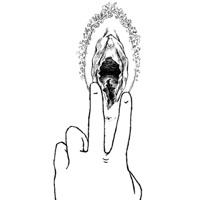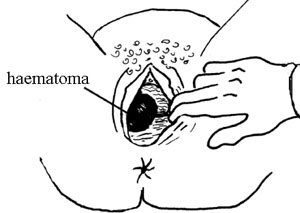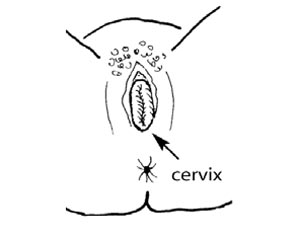5.1.5 Check the mother’s genitals for tears and other problems

Use a gloved hand to gently examine the mother’s genitals (Figure 5.3) for tears, blood clots, or a haematoma (bleeding under the skin). If the woman has a tear that needs to be sewn, apply pressure on it for 10 minutes with a clean cloth or pad and refer her to the health centre. If the tear is small, it can probably heal without being sewn, as long as it is kept very clean to prevent wound infection.
Ask her to rest as much as possible and tell her she should not climb up or down steps or steep hills. Someone else should do the cooking and cleaning for the family for a few days. To speed healing, she should also eat plenty of healthy food, keep the genital area clean (washing it with water after using the latrine) and cover it with a clean cloth or pad.
Bleeding under the skin (haematoma) or pain in the vagina
Sometimes the uterus gets tight and hard and there does not seem to be much bleeding, yet the mother still feels dizzy and weak. If this happens, she may have bleeding under the skin in her vagina called a haematoma (Figure 5.4). The skin in this area is often swollen, dark in colour, tender and soft.

Although a haematoma is painful, it is usually not serious unless it gets very large. If the haematoma is growing, press on the area with sterile gauze for 30 minutes or until it stops growing. If the mother has signs of shock, treat her for shock and take her to the nearest health facility so that the haematoma can be opened and the trapped blood can be let out.
Prolapsed cervix

Check to see if the cervix has prolapsed (dropped down to the vaginal opening; Figure 5.5). This problem is not dangerous, and the cervix will usually go back up inside the mother in a few days. Help the mother to raise her hips so that they are higher than her head. Ask her to do squeezing exercises with the muscles of her vagina and pelvic floor at least four times a day.
If the cervix stays at the vaginal opening for more than two weeks, the mother should be referred. A cervix that stays prolapsed can cause problems if the woman has another child.
5.1.4 Check for heavy bleeding (haemorrhage)
